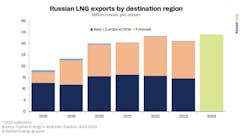Monthly average prices for crude oil have increased by a factor of five in less than 5 years since the end of 2003 and have nearly tripled in only the last 18 months. Global prices for propane and butane have also increased during this period, but at a noticeably slower pace. Thus, LPG has become relatively cheap during this rapid run-up in energy prices.
In the US, prices for propane and normal butane have risen by a factor of “only” 3.5 since late 2003. Likewise, spot prices for propane and butane in Northwest Europe have increased by a factor of roughly 3.6 and 3.9 in 5 years. In Japan, the relative increase in LPG spot prices has been somewhat more modest at about 3.3 and 3.5 times during the same period.
This relatively slow increase has shifted demand for LPG throughout the world as both a fuel and as an ethylene plant feedstock. For example, until 2005 LPG in Japan was a more expensive industrial fuel than kerosene throughout the year. From 2005 to 2007, LPG became a cheaper fuel than kerosene during many months each year. Starting in 2008, LPG has been a much cheaper fuel than kerosene during every month. Thus, demand for LPG has likely risen.
Similarly, LPG was never a competitively priced ethylene plant feedstock in Asia before the beginning of 2007. During the last 18 months, however, costs of producing ethylene from both propane and butane have been lower than for naphtha except during the peak winter heating season. Ethylene producers throughout Asia have been adding or restarting facilities that allow them to crack more LPG.
In Northwest Europe before 2006, propane was virtually never a competitively priced cracker feedstock, and butane was only attractive compared with naphtha during 4 or 5 months in the summer.
In 2008, Purvin & Gertz estimates that both propane and butane will be cheaper feedstocks than naphtha for 9 or 10 months out of the year.
Lastly, because of the large amount of feedstock flexibility among crackers in the US, cash production costs for all feedstocks have historically been fairly close to one another. In 2008 ethane, propane, and normal butane should all be much cheaper feedstocks than naphtha throughout the year.
Thus, LPG has become an attractive ethylene plant feedstock in all regions of the world. Demand for LPG as a cracker feedstock has increased accordingly.
The good news for LPG demand is that relatively weaker prices have resulted in stronger demand as both a fuel and as a cracker feedstock. The bad news is that absolute prices for LPG have soared to record highs. Demand by residential consumers, the world’s largest end-use sector, is stagnating or falling in essentially all regions.
Many consumers have resorted to conservation measures such as turning down thermostats in their homes or cooking food that requires less LPG (pasta rather than beans). Other consumers have reverted to other forms of cooking fuel such as coal, wood, and even dung.
So, are high prices good or bad for LPG demand? The answer is a likely a resounding…“both.” We expect that residential-commercial demand for LPG will grow by only 4%/year in 2008 and 2009 but that chemical demand will increase by more than 10%.

